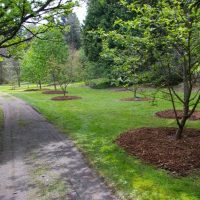Core Collection Highlight: Viburnum
Our Viburnum Collection is recognized as one of the top three national collections. Our taxonomic display currently is home to over 100 different kinds and 330 living specimens.
[Description references: “Viburnums — Shrubs for Every Season” by Michael Dirr.]
Here are a few samples of this diverse and ornamental shrub.
1) Viburnum carlesii var. bitchiuense Bitchu Viburnum
Wonderfully fragrant flowers in early spring.
Read moreExploding trees, now showing at your local Arboretum
March did not go out like a lamb, nor did it end with a whimper. No, this lion ended with a grand BANG!
A lightning strike from the massive thunderstorm that roared through Seattle yesterday was a direct hit on one of our largest trees in the Washington Park Arboretum.
A Grand Fir located in the Oak grove at the north end of the Arboretum was obliterated with one flash.
Glimpse into the Past – Thirty Years of Horticultural Outreach
When the Center for Urban Horticulture was established in 1980, one of the programmatic thrusts was to develop and carry out a comprehensive public outreach program.
Read moreEncouraging Native Pollinators at the UW Farm
UW graduate student Nicolette Neumann Levi is looking for ways to bring more native pollinators to the UW Farm.
Read moreMarch Color Appears at the Washington Park Arboretum, Part II
1) Acer tegmentosum ‘Joe Witt’ Stripebark Maple
A small- to medium-size tree with distinct striped patterns along the bark and branches
Named for a former Washington Park Arboretum curator
Located in the Joe Witt Winter Garden
2) Berberis x media ‘Arthur Menzies’ Hybrid Mahonia
Multi-stemmed shrub with prominent winter flowers
Loved by hummingbirds as a source of winter nectar
Located in the Joe Witt Winter Garden
3) Ceanothus ‘Puget Blue’ California Lilac
A fast growing, medium-sized shrub
Known for small dark, evergreen leaves and purplish-blue late spring flower
Located along the fence in the Graham Visitors Center’s parking lot
4) Magnolia x kewensis ‘Wada’s Memory’ Hybrid Magnolia
Selected from a group of seedlings from nurseryman, Koichiro Wada
Known for large and abundant spring flowers
Two specimens flank Arboretum Drive near the Hydrangea Collection
5) Nothofagus antarctica ‘Puget Pillar’ Southern Beech
A medium-sized deciduous tree native to Argentina and Chile
Known for a somewhat fastigiate growth habit
Located along the shore near Duck Bay
Currently flowering in the Washington Park Arboretum
In the old Nursery along Arboretum Drive there is a group of Chaenomeles cathayensis (Cathay or Chinese Quince) shrubs in full bloom. This cluster of three shrubs make for a huge display as they are about 15 ft. tall and 20+ ft. across. Covered in these lovely pinkish white flowers right now, they will bear very fragrant pear sized fruits in the autumn.
Read moreFarmer Reflection: Maya Garber-Yontz

The UW Farm. Oh what a place.
I was first introduced to the farm in August before my freshman year of college. I grew up with 18 raised beds in our backyard in Oregon that produced more vegetables than our family of four could use. My mom would fill baskets with the extra kale, peppers, tomatoes, lettuces, eggplants, cucumbers, and squash and send my brother and I off around the neighborhood to deliver the goodies.
Early Spring Has Begun!
1) Acer triflorum Three Flower Maple
A small, slow-growing deciduous tree 20’ to 45’ where it is native in Manchuria and Korea. An excellent landscape tree boasting light grey vertically-furrowed bark and vivid red and orange fall color. The name refers to its flowers, which are borne in clusters of three.
Discovered by noted plant explorer, Ernest H. Wilson in 1917.
Fiddleheads Forest Grove Dispatch: Sunny Days, a New Science Unit, and an Exploration of Friendship
The sun is shining, mosquitoes are buzzing, and blossoms are bursting open everywhere we look; it could just as easily be June in Seattle, but the calendar still tells us it’s winter no matter how incongruous that may seem. Students at the Fiddleheads Forest School are taking full advantage of the seasonal changes. The warm weather has meant that we are continuing to discover lots of mushrooms and fungus in and around the forest grove classroom.
Read moreGlimpse into the Past – Celebrating the Founder of the Center for Urban Horticulture
By John Wott, Director Emeritus
In those divisive times of the late 1960’s and 1970’s, many new ideas began to form regarding how to live on, properly use, and safeguard the resources on our earth. This included groups from the “flower children” to academics. Learned horticulturists, botanists, and academics in the Northwest created a plan which called for the creation of a new academic unit at the University of Washington to be called the Center for Urban Horticulture.